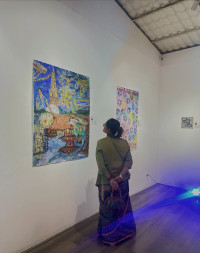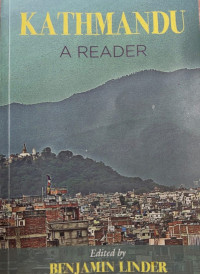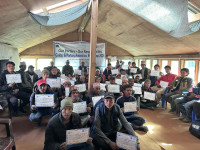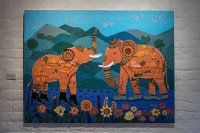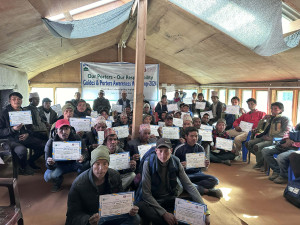Culture & Lifestyle
A look inside the bahas and bahis of the Valley
Amid the lockdown, how communities living in traditional courtyard settlements are coping with a crisis that demands social distancing.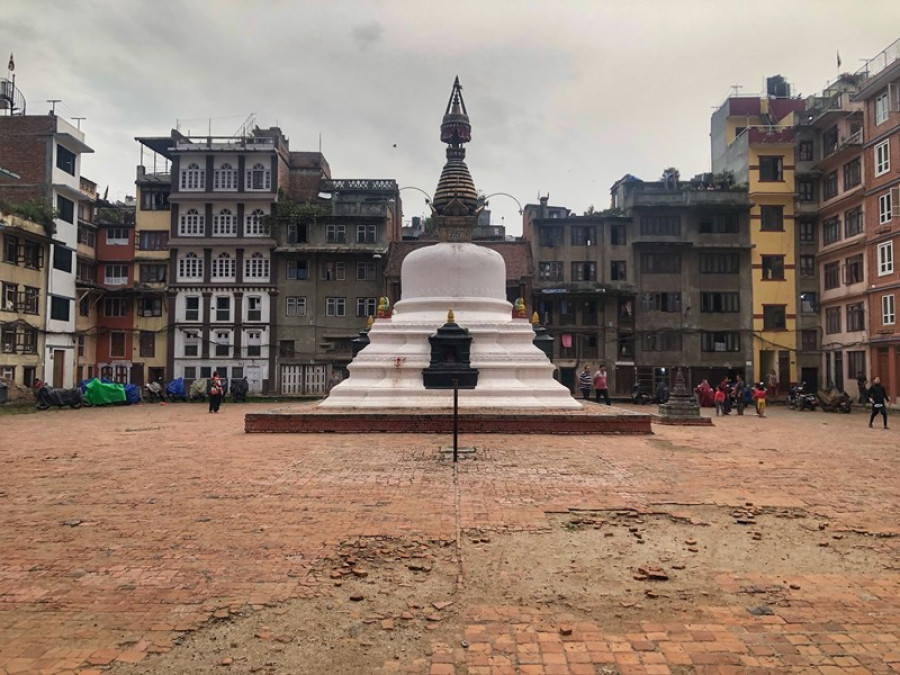
Srizu Bajracharya
In Patan’s bahas, mornings would usually start with the sound of ringing bells. Around 5 am, at the Hiranya Varna Mahavihar, a baha monastery that many know as the Golden Temple, a group of elders would sit down to chant the Namasangati Sutra Path, a Buddhist prayer. Others from the neighbourhood would light butter lamps. The prayers would go on all morning, with different groups coming in to read different Buddhist scriptures at different times.
On most days, around 9 am, Kiran Shakya, a local of Nakabahil, Patan, would take his daily walk around the Mahavihar. But since the lockdown, he has stopped going. Life around and inside the bahas have changed. “An eerie silence now fills the air,” he says. Nakabahil, a courtyard settlement that has about 250 houses, which was always full-of-life now is hushed. Besides the locals who live there, no strangers are allowed inside.
The Valley’s bahas and bahis have been known to house close-knit, core Newa settlements. This traditional architectural setting is built on the foundational practice and proliferation of Buddhism through sanghas, members in Viharas, and the main monasteries. These monasteries are attached to different communal courtyards, linked through narrow alleyways, called Lacchi, which leads to other courtyards like kacabaha or nani or chuka. For example, the Golden Temple in Kwa Baha, the main Buddhist monastery is attached to Nagbaha and Ikkhachhen baha.
While the Guthi system designates each family with responsibilities to uphold the tradition that has long been passed down from generation to generation, it is through the communities in these bahas and bahis that many cultural traditions continue. But as people are in close proximity to each other in this communal setting, many people are worried about the challenges of maintaining social distancing as Covid-19 cases increase in the country.
Where once homes around the bahas and bahis would have been hosting nakhatya, or gatherings during this time of the year in Patan, courtyards now are much quieter. Neighbours now wave at each other from terraces and converse from window to window rather than meeting at the patis. Close ones meet online via video chats than in person. And while the police enforce the lockdown outside, inside the bahas, local volunteers monitor the movement of people inside the courtyards.
At Nakabahil, even as children come out to play once in a while, or even if elders sit down in the phalchas for some relaxed times, locals make sure they are maintaining a safe social distance. Many prefer to buy groceries just from the local shop inside the baha itself.
“I had not considered this before, but it’s true that there is a possible risk of rampant spread in these courtyards if people are not careful. These are houses that live with extended families and where people are likely to take a stroll around the Chaityas or the nearby temples in the courtyards,” says Mohan Pant, a resident of Bhaktapur and a teacher at Khwopa Engineering College.
“People are likely to be intimidated with the idea of social distancing when your whole life you have immersed in a social setting, moreover tempted to breach the boundary these times have enforced,” he says. Pant has also studied about the residential courtyard settlements of Patan to analyse the residential setting of the historic core of Patan.
“The physical structure of bahas encourages people to engage with the community. The open courtyard allows for social engagement: there are phalchas and patis for people to sit and talk, wells to draw water out from, temples and even the alleyways are interconnected binding lives of people together,” he says. “Many of these houses that are small in space also ask people to come out for open space itself,” says Pant.
Because of its structure, it is tough for people to stay isolated. At Te Baha, in Kathmandu, that houses the Sankata temple, the large courtyard echoes with cackles of laughter as children play badminton and basketball in the evenings. Occasionally the police come in to monitor the lockdown too, during this time, the community people stay indoors. “But in the morning and in the evening people are usually out in the big space we have; it’s hard for people not to come outside,” says Bishwo Bijaya Bajracharya, advisor of Sankata Club and a priest at the Sankata Temple.
“In a way, although the world outside of the baha is under a strict lockdown, here inside life still has a positive outlook. Some locals still move around the area but cautiously, of course” he says.
And with so much uncertainty regarding the virus, time and again, conflicts have spurred. “There was one person who had gone to Ramechaap and had come back a few weeks ago, and so many people were concerned, as they feared the person could be a carrier of the virus,” says Ujwala Shakya, chair of Thyaka Misa Pucha. Soon after the person’s arrival, the community people found themselves muddled with questions: how do you stop someone from entering their own house and what if the person is infected?
“These are tough times to be in and that is making us wary about each other especially as we live in a close-knit community and if the virus does enter the community, there is the risk of rampant spread,” she says. The person was later allowed in but was asked to remain in quarantine for a few days.
Despite the challenges of maintaining social distancing while being under lockdown, these communities are also doing their bit to give back. The community of Te Baha has also taken this time to clean and upkeep the monuments in the area. “We have been taking this time to repair things around the area. We have already done some painting around the temple and the public space,” says Bajracharya. The Sankata temple, however remains closed for the public and only the priests are allowed in for daily rituals. “We have volunteers monitoring social distance and checking people who are moving in and out,” he adds.
Like Te Baha, many other bahas and bahis have also been coming up with their own programmes, many of which aim to be of help to the community. At Nakabahil, Thyaka Misa Puchha, in collaboration with Thyaka Sahakari with support from ward 16, organised a blood donation programme besides collecting money from the area to help families in the community that have been hit hard with the lockdown. Thyaka Sudhar Sangha, a local organisation in Patan, distributed about Rs 5,000 each to 20 families that they identified as living in a vulnerable situation during the lockdown.
Another committee, the Nakabahil Tol Bikash Samiti, has also been working to provide telemedical-counselling through doctors in their community. “The idea is to help people connect to the right medical help. It’s not for health-check up but rather to help them find the right medical attention,” says Kiran Shakya. For social and religious inter-exchange, many communities have also moved online for discussions and live prayer programmes on Facebook.
“It’s a stressful time for everyone, not just us. But I also believe it’s time for the communities to help the people who need a hand to survive this crisis,” says Shakya. “We do everything as a community, celebrating and engaging socially and religiously; we also need communal solidarity to get through this tough time,” says Shakya.




 8.12°C Kathmandu
8.12°C Kathmandu


